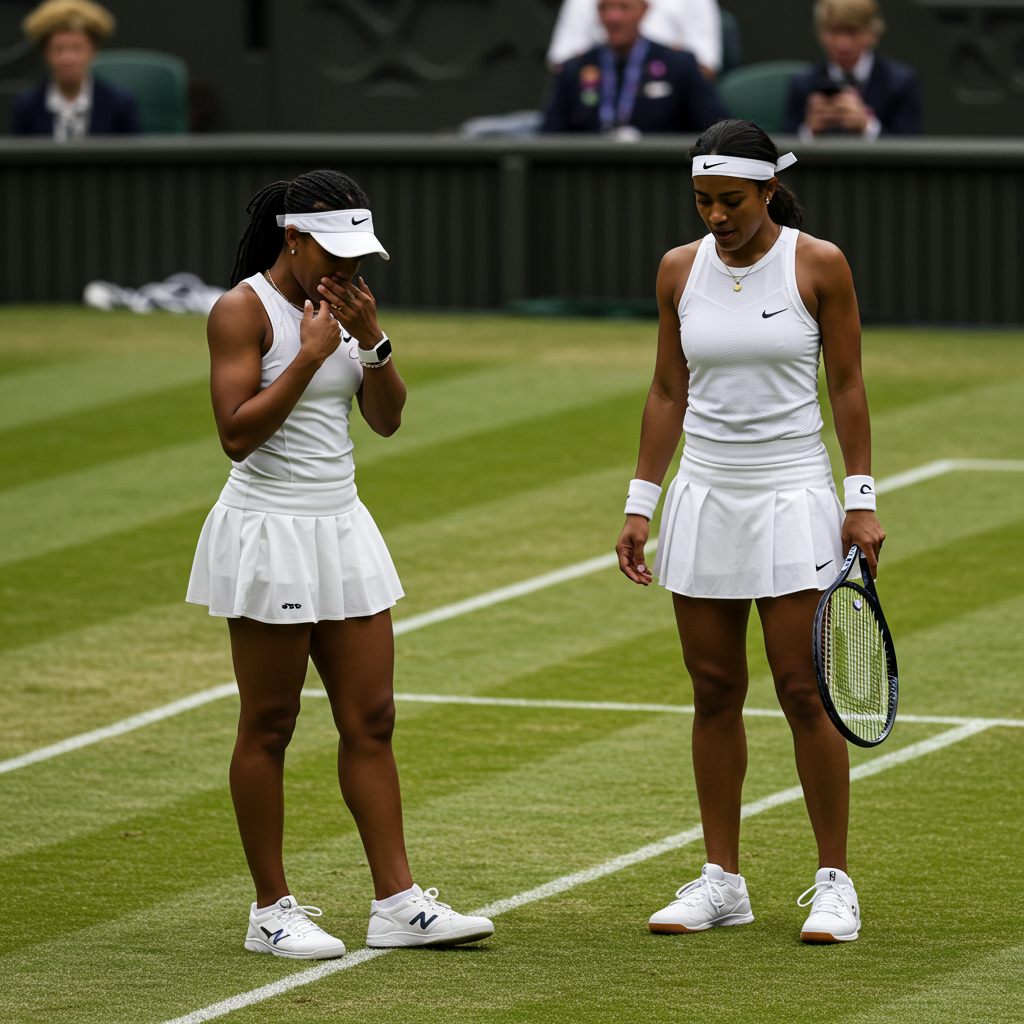wimbledon 2025 exploded into unexpected drama during its opening days, marked by a stunning upset that saw women’s second seed Coco Gauff crash out in the first round. The young American star, fresh off her second Grand Slam title at the French Open, suffered a straight-sets defeat to Ukraine’s Dayana Yastremska. This early exit for Gauff was not an isolated incident. The initial rounds witnessed a record-tying number of seeded players tumbling out of the competition, reshaping the landscape of both the men’s and women’s draws and promising a tournament full of surprises at the All England Club.
The Shock of the Tournament: Gauff’s Early Exit
The focus of the early action quickly shifted to Court 1 where Coco Gauff faced the unseeded Dayana Yastremska. The match, originally slated for Centre Court but moved due to scheduling delays, ended in a decisive 7-6 (7-3), 6-1 victory for the Ukrainian world No. 42. This result was widely described as a “staggering” upset, representing the biggest seed to fall in the tournament’s initial stages.
Gauff’s performance was uncharacteristically error-prone. Her formidable serve, a key weapon, seemed to desert her, contributing to nine double faults and allowing Yastremska to break her serve four times. Gauff appeared a shadow of the player who had recently conquered the clay courts of Paris. The quick transition from clay to grass, coupled with the emotional and mental demands following her French Open triumph, seemed to weigh heavily on her.
In a tearful post-match press conference, Gauff admitted feeling “a little bit overwhelmed” by the attention and demands that followed her major victory. She felt she hadn’t had enough time to truly celebrate before needing to refocus for the grass season. Gauff also highlighted the difficulty she faces adapting her game to the grass surface. Despite her famous breakthrough at Wimbledon in 2019 as a 15-year-old, where she reached the fourth round, the All England Club remains the only Grand Slam where she hasn’t reached the semi-finals. She acknowledged the need to adjust her playing style but expressed faith in her ability to succeed on grass in the future with necessary changes.
Her opponent, Dayana Yastremska, played a brilliant match, showing no signs of the supposed discomfort with grass that has been occasionally noted. Yastremska had recent positive results on the surface, including a run to the final in Nottingham just weeks before Wimbledon, suggesting a growing affinity for grass. She capitalized effectively on Gauff’s struggles, delivering powerful groundstrokes and appearing confident and sure-footed on the sometimes-slippery surface. This victory marked only the fifth time in 20 attempts that Yastremska had defeated a player ranked in the top 10, underscoring the magnitude of her performance.
A Record Wave of Seeded Casualties
The early exit of Coco Gauff was merely the tip of the iceberg in a remarkable display of upsets. By the end of the second day of Wimbledon 2025, an astonishing 23 seeded players – 13 men and 10 women – were already out of the tournament. This figure ties the record for the most seeds eliminated by this stage at any Grand Slam event since the seeding was expanded to 32 players in each singles draw in 2001.
Prominent Women’s Seeds Fall
Beyond Gauff, the women’s draw saw several other top players bow out unexpectedly. Third seed Jessica Pegula suffered a swift and surprising defeat to Italian world No. 116 Elisabetta Cocciaretto, losing 6-2, 6-3 in under an hour. Pegula praised her opponent’s “insane” performance but admitted her own game wasn’t at its best, calling the loss a “bummer” and noting it was her first first-round Slam exit in a significant period.
Fifth seed Qinwen Zheng of China also exited in the first round, marking her third consecutive opening loss at Wimbledon. She was defeated by Czech doubles specialist Katerina Siniakova. Other notable women’s seeds eliminated included #9 Paula Badosa, #15 Karolina Muchova, and #20 Jelena Ostapenko. American tenth seed Emma Navarro secured a significant win by defeating two-time Wimbledon champion Petra Kvitova in Kvitova’s final appearance at the Championships before retirement.
Men’s Draw Not Immune to Upsets
The men’s draw was equally impacted by the wave of early exits. Men’s third seed Alexander Zverev was knocked out in a grueling five-set battle that spanned two days against Frenchman Arthur Rinderknech. Zverev’s 7-6 (7-3), 6-7 (8-10), 6-3, 6-7 (7-5), 6-4 defeat marked his first first-round exit at a Grand Slam since Wimbledon 2019.
Seventh seed Lorenzo Musetti, a semi-finalist last year, also fell early, losing to Nikoloz Basilashvili. Eighth seed Holger Rune and ninth seed Daniil Medvedev were among the other highly-ranked players who exited the competition before the second round. This unprecedented number of early upsets created a sense of unpredictability and opened up sections of the draws for less-fancied players.
Top Contenders Navigate Early Challenges
While many seeds stumbled, several top players successfully navigated their opening matches, though not always without facing stern tests. Seven-time Wimbledon champion Novak Djokovic survived a four-set scare against Alexandre Muller. After cruising through the first set, Djokovic lost the second set tie-breaker (6-1, 6-7 (7-9), 6-2, 6-2). He received a medical timeout before ultimately rallying to win the match just before the 11 pm curfew. His victory sets up an intriguing second-round clash against Great Britain’s Dan Evans, who secured his first Wimbledon win in four years. Evans expressed excitement at the prospect of facing the “greatest of all time” on Centre Court.
Defending women’s singles champion Barbora Krejcikova also faced a challenge in her opening match against promising 20-year-old Alexandra Eala from the Philippines. Krejcikova lost the first set 3-6 before finding her form and winning the next two 6-2, 6-1. She later praised Eala’s aggressive play and potential, acknowledging the young player had pushed her hard.
Elsewhere, world No. 1 Jannik Sinner eased into the second round with a comfortable straight-sets victory over compatriot Luca Nardi. Five-time Grand Slam champion Iga Swiatek, seeded eighth, also advanced in straight sets, showing positive signs despite Wimbledon historically being her least successful major. American fifth seed Taylor Fritz won a tough five-setter that concluded on day two after being suspended due to light. These wins highlighted the resilience and determination of the top players who managed to overcome their early-round opponents amidst the chaos of upsets.
The high rate of early seed eliminations can be attributed to several factors. The swift transition from the clay courts of the French Open to the grass of Wimbledon presents a unique challenge, requiring significant technical and physical adjustments that some players manage better than others. The mental fatigue following a deep run or victory at the French Open, as Gauff mentioned, can also play a role. Furthermore, the depth of talent in modern tennis means unseeded players are increasingly capable of challenging and defeating top-ranked opponents, especially when those opponents are not fully comfortable on the specific surface or are facing tough draws. The unpredictable nature of grass courts, with their lower bounce and faster play, often favors aggressive players and can lead to unexpected results, creating the ‘Wimbledon magic’ often associated with its early rounds.
Frequently Asked Questions
Why was Coco Gauff’s Wimbledon loss considered a major upset?
Coco Gauff’s first-round exit was a significant shock because she was the tournament’s second seed and had recently won the French Open, her second Grand Slam title. Losing to Dayana Yastremska, ranked world No. 42, represented a considerable difference in ranking and recent major success. It was the highest seed to be eliminated in the early stages of Wimbledon 2025 and Gauff’s earliest Grand Slam exit since Wimbledon 2023.
How many seeded players were eliminated early at Wimbledon this year?
By the end of the first two days of Wimbledon 2025, a record-tying number of seeded players were knocked out. A total of 23 seeds – 13 men and 10 women – suffered first-round defeats. This equals the most seeds eliminated by day two of any Grand Slam tournament since the format of seeding 32 players in each singles draw was introduced in 2001, highlighting an unusually unpredictable start to the championships.
What factors contributed to the high number of upsets at Wimbledon?
Several elements likely contributed to the unprecedented number of early seed eliminations. A major factor is the rapid surface change from the clay courts of the French Open to Wimbledon’s grass, which requires difficult adjustments. Players fresh off deep runs or victories at Roland Garros, like Coco Gauff, may also experience mental and physical fatigue. Additionally, the competitive depth in professional tennis means unseeded players are highly capable opponents on their best day, and the unique characteristics of grass courts can sometimes level the playing field, favoring aggressive play and making upsets more likely.
Wimbledon 2025 has certainly started with a bang, delivering a slew of upsets that have captured headlines and left predictions in tatters. Coco Gauff’s early departure stands out, but it is part of a broader narrative of seeded players struggling to find their footing on the grass. While top contenders like Djokovic and Sinner advanced, their journeys underscore the challenges faced by even the game’s elite in navigating the initial rounds. As the tournament progresses, the open draws resulting from these upsets promise an exciting and unpredictable path to the finals, highlighting the unique magic and challenge of the All England Club.



